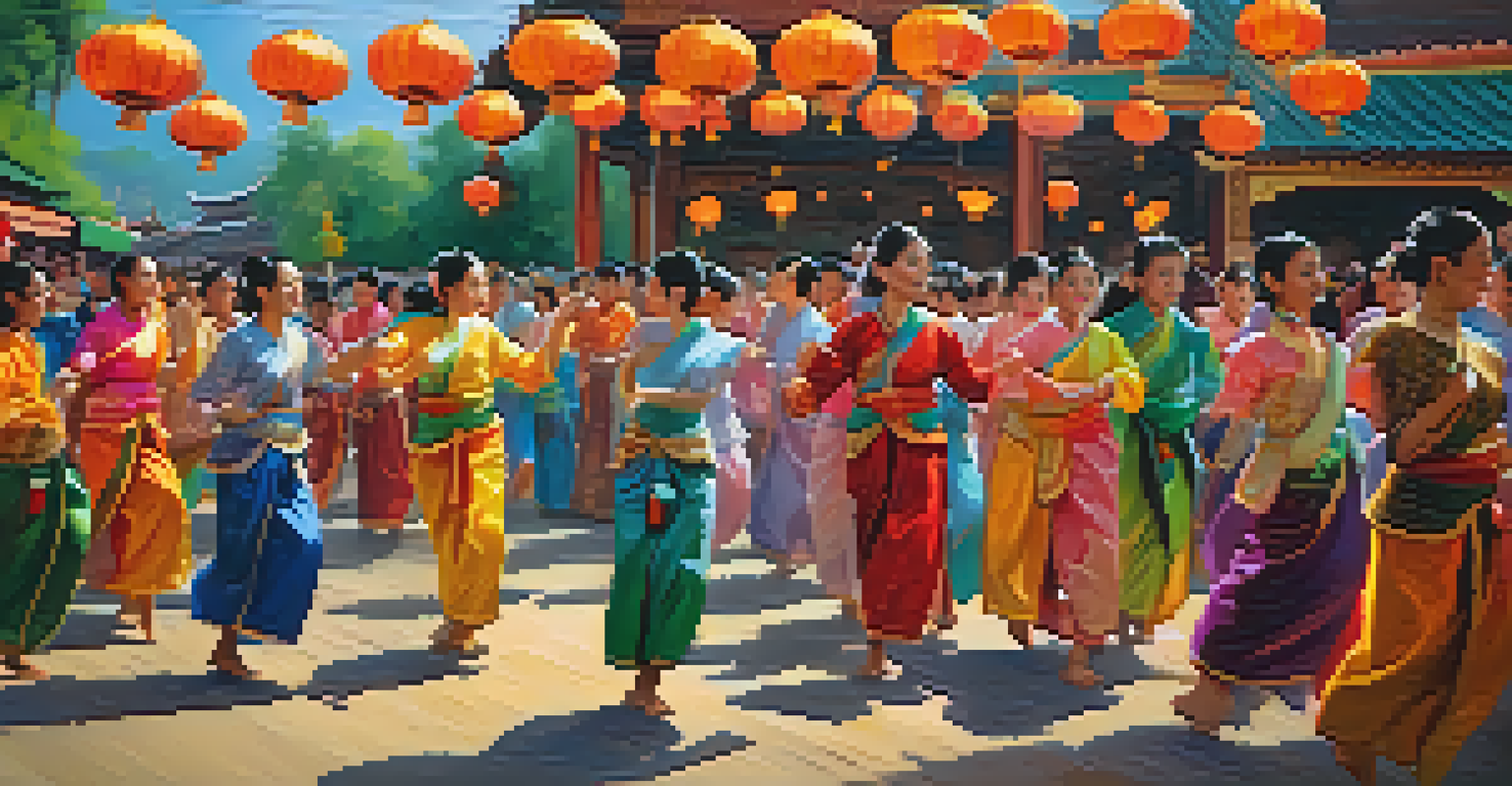Cultural Narratives: Thai Cinema's Reflection of Society

The Historical Evolution of Thai Cinema
Thai cinema has a rich history that dates back to the early 20th century, beginning with silent films that introduced Thai audiences to storytelling through moving images. Over the decades, the industry evolved, reflecting not just artistic trends but also the political and social climate of the times. For instance, during periods of political upheaval, films often tackled themes of resistance and identity, providing a lens through which society could reflect on its challenges.
Cinema is a mirror by which we often see ourselves.
As Thailand transitioned from a monarchy to a more democratic society, the narratives within films began to mirror this evolution. Directors and screenwriters started to explore more personal stories, delving into the complexities of love, family, and societal expectations. This shift allowed audiences to see themselves in the characters, fostering a deeper connection to the narratives presented on screen.
Today, Thai cinema continues to evolve, embracing both local and global influences. Films often blend traditional storytelling with modern techniques, showcasing the unique Thai identity while also appealing to international audiences. This dynamic interplay highlights the ongoing relationship between cinema and society, making Thai films a vital cultural artifact.
Exploring Cultural Identity Through Film
One of the most compelling aspects of Thai cinema is its exploration of cultural identity. Films often portray the rich tapestry of Thai life, showcasing the diversity of its people and traditions. From the rural landscapes to the urban hustle, these settings serve as backdrops for stories that celebrate the country's cultural heritage while also addressing contemporary issues.

For example, movies like 'The Love of Siam' and 'Bad Genius' tackle themes of family dynamics, friendship, and societal pressure, resonating with audiences on multiple levels. These narratives not only entertain but also provoke thought about what it means to be Thai in a rapidly changing world. By addressing both traditional values and modern dilemmas, these films create a dialogue about cultural identity.
Evolution of Thai Cinema's Themes
Thai cinema has evolved from silent films to complex narratives that reflect the nation's cultural identity and socio-political climate.
Furthermore, the representation of gender roles and family structures in Thai cinema offers insights into societal expectations. As filmmakers push boundaries and challenge stereotypes, audiences are invited to reflect on their own beliefs and values. This ongoing dialogue is essential for understanding the complexities of Thai culture and its evolution.
Socio-Political Commentary in Thai Films
Thai cinema often serves as a platform for socio-political commentary, reflecting the realities and struggles faced by the Thai people. Many films tackle pressing issues like corruption, inequality, and the impact of globalization, providing audiences with a mirror to their societal challenges. Through storytelling, filmmakers can critique the status quo while also sparking conversation.
Films are often the best way to understand a culture.
For instance, films such as 'The Letter' and 'Ghost of Mae Nak' address themes of injustice and historical trauma, allowing viewers to engage with their past. These narratives not only entertain but also educate, encouraging audiences to reflect on the socio-political landscape of Thailand. This element of Thai cinema is crucial for fostering awareness and understanding.
Moreover, the ability of films to highlight grassroots movements and social change has made them powerful tools for advocacy. As filmmakers document real-life struggles and triumphs, they inspire audiences to consider their roles in shaping society. This blend of art and activism underscores the importance of cinema as a vehicle for change.
The Impact of Globalization on Thai Cinema
Globalization has profoundly influenced Thai cinema, introducing new narratives, styles, and production techniques. As international films gain popularity, Thai filmmakers are increasingly incorporating global themes while retaining their unique cultural perspectives. This fusion of influences enriches the storytelling landscape and broadens audience appeal.
For example, the success of films like 'Orochi' and 'Bad Genius' demonstrates the potential for Thai stories to resonate beyond national borders. By exploring universal themes such as ambition and love, these films have garnered international acclaim, showcasing the versatility of Thai cinema. This global recognition also encourages filmmakers to experiment with new genres and storytelling methods.
Globalization's Impact on Filmmaking
The influence of globalization has led Thai filmmakers to blend traditional storytelling with global themes, enhancing the appeal of their films.
However, the challenge lies in maintaining cultural authenticity while appealing to a broader audience. As Thai cinema navigates this delicate balance, filmmakers must find ways to celebrate their heritage while engaging with global narratives. This ongoing evolution reflects the complexities of cultural identity in a globalized world.
Gender Representation in Thai Cinema
Gender representation in Thai cinema has been a subject of significant evolution, reflecting changing societal norms and attitudes towards women. Historically, female characters were often relegated to traditional roles, but contemporary Thai films increasingly showcase strong, complex women who defy stereotypes. This shift allows for more nuanced storytelling that resonates with modern audiences.
Films like 'Pee Mak' and 'The Teacher's Diary' highlight the diverse experiences of women in Thai society, addressing issues such as empowerment and resilience. By portraying female characters in a range of roles—be it as leaders, warriors, or nurturers—Thai cinema contributes to a broader understanding of gender dynamics. These narratives challenge audiences to rethink their perceptions of women in society.
Moreover, as discussions around gender equality gain traction, filmmakers are taking a more active role in representing women's voices and experiences. This cultural shift not only impacts the film industry but also encourages societal change, fostering greater awareness and understanding of women's rights in Thailand and beyond.
The Role of Traditional Folklore in Thai Cinema
Traditional folklore plays a vital role in enriching Thai cinema, providing a wealth of stories that reflect the country's cultural heritage. Many filmmakers draw inspiration from folklore, weaving these narratives into contemporary plots to create a unique cinematic experience. This blend of old and new not only entertains but also preserves Thailand's rich storytelling traditions.
For instance, films like 'Nang Nak' and 'The Legend of King Naresuan' bring ancient tales to life, showcasing the beauty and complexity of Thai folklore. These stories often explore themes of love, sacrifice, and the supernatural, resonating with audiences of all ages. By adapting folklore for the screen, filmmakers honor their cultural roots while making these tales accessible to modern viewers.
Gender Representation in Film
Contemporary Thai cinema increasingly features strong female characters, challenging traditional gender roles and promoting empowerment.
Furthermore, the incorporation of traditional elements in film can foster a sense of pride and identity among audiences. As viewers engage with these stories, they are reminded of the values and beliefs that shape their culture. This connection to folklore not only enriches the cinematic experience but also strengthens cultural identity in a globalized world.
The Future of Thai Cinema: Challenges and Opportunities
As Thai cinema continues to evolve, it faces both challenges and opportunities in a rapidly changing landscape. The rise of streaming platforms and digital media has transformed how audiences consume films, prompting filmmakers to adapt their storytelling techniques. This shift presents an opportunity for Thai cinema to reach wider audiences, both locally and globally.
However, the challenge remains in balancing artistic integrity with commercial viability. As filmmakers navigate this complex terrain, they must find innovative ways to tell authentic Thai stories while appealing to diverse audiences. This balancing act is crucial for the continued growth and success of Thai cinema in the global market.

Moreover, the future of Thai cinema also hinges on fostering new talent and encouraging diverse voices within the industry. By supporting emerging filmmakers and embracing innovation, Thai cinema can continue to thrive and resonate with audiences. This commitment to growth and inclusivity will ensure that Thai cinema remains a vibrant reflection of its society for years to come.